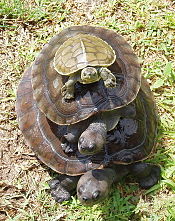| Mekong snail-eating turtle | |
|---|---|

| |
| Scientific classification | |
| Domain: | Eukaryota |
| Kingdom: | Animalia |
| Phylum: | Chordata |
| Class: | Reptilia |
| Order: | Testudines |
| Suborder: | Cryptodira |
| Superfamily: | Testudinoidea |
| Family: | Geoemydidae |
| Genus: | Malayemys |
| Species: | M. subtrijuga
|
| Binomial name | |
| Malayemys subtrijuga | |
| Synonyms | |
| |
The Mekong snail-eating turtle (Malayemys subtrijuga) is a species of turtle in the family Geoemydidae. It was monotypic within the genus Malayemys until Brophy (2004, 2005)[4] reevaluated (based on morphology) Malayemys macrocephala (Gray, 1859),[5] which has been long time considered to be a synonym of M. subtrijuga.
Distribution
The Mekong snail-eating turtle is found in the Mekong River basin of Cambodia, Laos, southern Vietnam, and Thailand and the northern Malay Peninsula, and Java, Indonesia.[4][6] It could have been introduced to Java via human intervention from the Mekong River Basin. The occurrence of the species in Indonesia is regarded by Brophy (2005) to be allochthonous, i.e., non-native (Sumatra) or extinct (Java).[4]
References
- ^ Horne, B.D.; McCormack, T.; Timmins, R.J. (2021). "Malayemys subtrijuga". IUCN Red List of Threatened Species. 2021: e.T123770834A2929454. doi:10.2305/IUCN.UK.2021-1.RLTS.T123770834A2929454.en. Retrieved 16 November 2021.
- ^ "Appendices | CITES". cites.org. Retrieved 2022-01-14.
- ^ Schlegel, Hermann and Müller, Salomon. (1845). Over de Schildpadden van den Indischen Archipel, beschrijving einer nieuwe soort van Sumatra. In: Temminck, C.J. (Ed.). Verhandelingen over de Natuurlijke Geschiendenis der Nederlandsche Overzeesche Bezittingen 1839–44. Part 3. Zoologie, Schildpadden. Leiden: Luchtmans and van der Hoek, pp. 29–36.
- ^ a b c Brophy, Timothy R. (2004). "Geographic variation and systematics in the south-east Asian turtles of the genus Malayemys (Testudines: Bataguridae)". Hamadryad. 29: 63–73 – via Digital Commons.
- ^ Gray, John Edward. (1859). Description of a new species of freshwater tortoise from Siam. Proceedings of the Zoological Society of London 1859(27):478–479.
- ^ Brophy, Timothy R. (2005). "Geographic distribution of the Southeast Asian turtles in the Genus Malayemys (Testudines: Bataguridae)". Bulletin of the Chicago Herpetological Society. 40: 21–33 – via Digital Commons.


